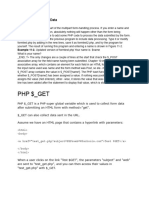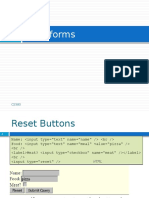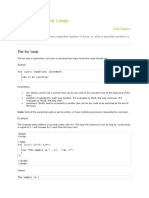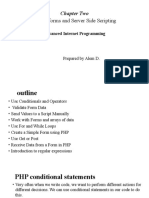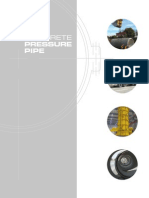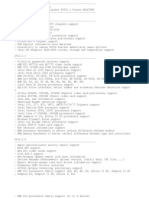Web Programming Step by Step: Reset Buttons (6.2.7)
Uploaded by
haripokhrelWeb Programming Step by Step: Reset Buttons (6.2.7)
Uploaded by
haripokhrelWeb Programming Step by Step
Lecture 10 More HTML Forms; Posting Data
Reading: 6.3 - 6.5 Except where otherwise noted, the contents of this presentation are Copyright 2009 Marty Stepp and Jessica Miller.
Reset buttons (6.2.7)
Name: <input type="text" name="name" /> <br /> Food: <input type="text" name="meal" value="pizza" /> <br /> <label>Meat? <input type="checkbox" name="meat" /></label> <br /> <input type="reset" /> Name: Food: Meat?
when clicked, returns all form controls to their initial values specify custom text on the button by setting its value attribute
Grouping input: <fieldset>, <legend> (6.2.8)
groups of input fields with optional caption (block)
<fieldset> <legend>Credit cards:</legend> <input type="radio" name="cc" value="visa" checked="checked" /> Visa <input type="radio" name="cc" value="mastercard" /> MasterCard <input type="radio" name="cc" value="amex" /> American Express </fieldset> Credit cards: Visa MasterCard American Express
fieldset groups related input fields, adds a border; legend supplies a caption
Common UI control errors
I changed the form's HTML code ... but when I refresh, the page doesn't update! By default, when you refresh a page, it leaves the previous values in all form controls it does this in case you were filling out a long form and needed to refresh/return to it if you want it to clear out all UI controls' state and values, you must do a full refresh Firefox: Shift-Ctrl-R Mac: Shift-Command-R
Styling form controls (6.2.9)
element[attribute="value"] { property : value; property : value; ... property : value; } input[type="text"] { background-color: yellow; font-weight: bold; }
Borat
attribute selector: matches only elements that have a particular attribute value useful for controls because many share the same element (input)
Hidden input parameters (6.3.2)
<input <input <input <input type="text" name="username" /> Name <br /> type="text" name="sid" /> SID <br /> type="hidden" name="school" value="UW" /> type="hidden" name="year" value="2048" /> Name SID
an invisible parameter that is still passed to the server when form is submitted useful for passing on additional state that isn't modified by the user
6.3: Submitting Data
6.1: Form Basics 6.2: Form Controls 6.3: Submitting Data 6.4: Processing Form Data in PHP
Problems with submitting data
<label><input type="radio" name="cc" /> Visa</label> <label><input type="radio" name="cc" /> MasterCard</label> <br /> Favorite Star Trek captain: <select name="startrek"> <option>James T. Kirk</option> <option>Jean-Luc Picard</option> </select> <br />
Visa MasterCard Favorite Star Trek captain:
this form submits to our handy params.php tester page the form may look correct, but when you submit it... [cc] => on, [startrek] => Jean-Luc Picard
The value attribute
<label><input type="radio" name="cc" value="visa" /> Visa</label> <label><input type="radio" name="cc" value="mastercard" /> MasterCard</label> <br /> Favorite Star Trek captain: <select name="startrek"> <option value="kirk">James T. Kirk</option> <option value="picard">Jean-Luc Picard</option> </select> <br />
Visa MasterCard Favorite Star Trek captain:
value attribute sets what will be submitted if a control is selected [cc] => visa, [startrek] => picard
URL-encoding (6.3.1)
certain characters are not allowed in URL query parameters: examples: " ", "/", "=", "&" when passing a parameter, it is URL-encoded (reference table) "Marty's cool!?" "Marty%27s+cool%3F%21" you don't usually need to worry about this: the browser automatically encodes parameters before sending them the PHP $_REQUEST array automatically decodes them ... but occasionally the encoded version does pop up (e.g. in Firebug)
Submitting data to a web server
though browsers mostly retrieve data, sometimes you want to submit data to a server Hotmail: Send a message Flickr: Upload a photo Google Calendar: Create an appointment the data is sent in HTTP requests to the server with HTML forms with Ajax (seen later) the data is placed into the request as parameters
HTTP GET vs. POST requests (6.3.3)
GET : asks a server for a page or data if the request has parameters, they are sent in the URL as a query string POST : submits data to a web server and retrieves the server's response if the request has parameters, they are embedded in the request's HTTP packet, not the URL For submitting data, a POST request is more appropriate than a GET GET requests embed their parameters in their URLs URLs are limited in length (~ 1024 characters) URLs cannot contain special characters without encoding private data in a URL can be seen or modified by users
Form POST example
<form action="http://foo.com/app.php" method="post"> <div> Name: <input type="text" name="name" /> <br /> Food: <input type="text" name="meal" /> <br /> <label>Meat? <input type="checkbox" name="meat" /></label> <br /> <input type="submit" /> <div> </form> Name: Food: Meat?
GET or POST?
if ($_SERVER["REQUEST_METHOD"] == "GET") { # process a GET request ... } elseif ($_SERVER["REQUEST_METHOD"] == "POST") { # process a POST request ... }
some PHP pages process both GET and POST requests to find out which kind of request we are currently processing, look at the global $_SERVER array's "REQUEST_METHOD" element
Uploading files (6.3.4)
<form action="http://webster.cs.washington.edu/params.php" method="post" enctype="multipart/form-data"> Upload an image as your avatar: <input type="file" name="avatar" /> <input type="submit" /> </form> Upload an image as your avatar:
add a file upload to your form as an input tag with type of file must also set the enctype attribute of the form it makes sense that the form's request method must be post (an entire file can't be put into a URL!) form's enctype (data encoding type) must be set to multipart/form-data or else the file will not arrive at the server
6.4: Processing Form Data in PHP
6.1: Form Basics 6.2: Form Controls 6.3: Submitting Data 6.4: Processing Form Data in PHP
"Superglobal" arrays (6.4.1)
Array $_REQUEST $_GET, $_POST $_SERVER, $_ENV $_FILES $_SESSION, $_COOKIE Description parameters passed to any type of request parameters passed to GET and POST requests information about the web server files uploaded with the web request "cookies" used to identify the user (seen later)
PHP superglobal arrays contain information about the current request, server, etc.: These are special kinds of arrays called associative arrays.
Associative arrays (6.4.1)
$blackbook = array(); $blackbook["marty"] = "206-685-2181"; $blackbook["stuart"] = "206-685-9138"; ... print "Marty's number is " . $blackbook["marty"] . ".\n";
associative array (a.k.a. map, dictionary, hash table) : uses non-integer indexes associates a particular index "key" with a value key "marty" maps to value "206-685-2181" syntax for embedding an associative array element in interpreted string:
print "Marty's number is {$blackbook['marty']}.\n";
Processing an uploaded file in PHP (6.4.3)
uploaded files are placed into global array $_FILES, not $_REQUEST each element of $_FILES is itself an associative array, containing: name : the local filename that the user uploaded type : the MIME type of data that was uploaded, such as image/jpeg size : file's size in bytes tmp_name : a filename where PHP has temporarily saved the uploaded file to permanently store the file, move it from this location into some other file
Uploading details
<input type="file" name="avatar" />
example: if you upload borat.jpg as a parameter named avatar, $_FILES["avatar"]["name"] will be "borat.jpg" $_FILES["avatar"]["type"] will be "image/jpeg" $_FILES["avatar"]["tmp_name"] will be something like "/var/tmp /phpZtR4TI"
Processing uploaded file, example
$username = $_REQUEST["username"]; if (is_uploaded_file($_FILES["avatar"]["tmp_name"])) { move_uploaded_file($_FILES["avatar"]["tmp_name"], "$username/avatar.jpg"); print "Saved uploaded file as $username/avatar.jpg\n"; } else { print "Error: required file not uploaded"; }
functions for dealing with uploaded files: is_uploaded_file(filename) returns TRUE if the given filename was uploaded by the user move_uploaded_file(from, to) moves from a temporary file location to a more permanent file proper idiom: check is_uploaded_file, then do move_uploaded_file
Including files: include (5.4.2)
include("filename"); include("header.php");
inserts the entire contents of the given file into the PHP script's output page encourages modularity useful for defining reused functions needed by multiple pages
You might also like
- An Introduction To The Psychology of ArchitectureNo ratings yetAn Introduction To The Psychology of Architecture19 pages
- Dealing With Forms: Variables From Outside of PHPNo ratings yetDealing With Forms: Variables From Outside of PHP15 pages
- Client-Side Form Validation (Usually With Javascript Embedded in The Web Page)No ratings yetClient-Side Form Validation (Usually With Javascript Embedded in The Web Page)4 pages
- Form Processing in PHP: Dr. Charles SeveranceNo ratings yetForm Processing in PHP: Dr. Charles Severance49 pages
- Unit I Chapter 2 Handling Html Form with PhpNo ratings yetUnit I Chapter 2 Handling Html Form with Php10 pages
- What Is PHP?: I (FI Short For "Forms Interpreter")No ratings yetWhat Is PHP?: I (FI Short For "Forms Interpreter")21 pages
- Chapter Two: HTML Forms and Server Side ScriptingNo ratings yetChapter Two: HTML Forms and Server Side Scripting68 pages
- Chapter - 4 Creating and Validating Forms Marks-12: Content OutlineNo ratings yetChapter - 4 Creating and Validating Forms Marks-12: Content Outline26 pages
- Chapter 4 Creating and Validating FormsNo ratings yetChapter 4 Creating and Validating Forms41 pages
- HTML Forms and Server Side Scripting: Chapter TwoNo ratings yetHTML Forms and Server Side Scripting: Chapter Two38 pages
- Web Based Programming: BCA Semester: II L-15-17No ratings yetWeb Based Programming: BCA Semester: II L-15-1739 pages
- PHP Interview Questions, Answers, and Explanations: PHP Certification Review: PHP FAQFrom EverandPHP Interview Questions, Answers, and Explanations: PHP Certification Review: PHP FAQNo ratings yet
- For RCC Frame Structure Buildings Up To Three StoriesNo ratings yetFor RCC Frame Structure Buildings Up To Three Stories1 page
- Computer Organization Architecture RCS 302No ratings yetComputer Organization Architecture RCS 3022 pages
- Assessment Tool For MRF NSCP 2010 Geotech Hazard For EqNo ratings yetAssessment Tool For MRF NSCP 2010 Geotech Hazard For Eq9 pages
- Legacy Report: ICC Evaluation Service, IncNo ratings yetLegacy Report: ICC Evaluation Service, Inc2 pages
- CSA NOTES - Green Building Index - ResidentialNo ratings yetCSA NOTES - Green Building Index - Residential19 pages
- Method Statement FOR Installation of Switchboards: M & E Contractor100% (1)Method Statement FOR Installation of Switchboards: M & E Contractor6 pages
- How To Prune Young and Bearing Apple Trees100% (1)How To Prune Young and Bearing Apple Trees13 pages
- Turning Green Into Gold Are View On The Economics of Green BuildingsNo ratings yetTurning Green Into Gold Are View On The Economics of Green Buildings13 pages
- Design and Construction of Concrete Bridges - Chapter 5No ratings yetDesign and Construction of Concrete Bridges - Chapter 568 pages
- Client-Side Form Validation (Usually With Javascript Embedded in The Web Page)Client-Side Form Validation (Usually With Javascript Embedded in The Web Page)
- What Is PHP?: I (FI Short For "Forms Interpreter")What Is PHP?: I (FI Short For "Forms Interpreter")
- Chapter - 4 Creating and Validating Forms Marks-12: Content OutlineChapter - 4 Creating and Validating Forms Marks-12: Content Outline
- PHP Interview Questions, Answers, and Explanations: PHP Certification Review: PHP FAQFrom EverandPHP Interview Questions, Answers, and Explanations: PHP Certification Review: PHP FAQ
- For RCC Frame Structure Buildings Up To Three StoriesFor RCC Frame Structure Buildings Up To Three Stories
- Assessment Tool For MRF NSCP 2010 Geotech Hazard For EqAssessment Tool For MRF NSCP 2010 Geotech Hazard For Eq
- Method Statement FOR Installation of Switchboards: M & E ContractorMethod Statement FOR Installation of Switchboards: M & E Contractor
- Turning Green Into Gold Are View On The Economics of Green BuildingsTurning Green Into Gold Are View On The Economics of Green Buildings
- Design and Construction of Concrete Bridges - Chapter 5Design and Construction of Concrete Bridges - Chapter 5

















